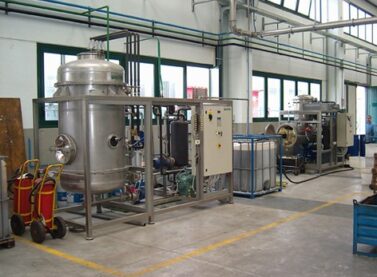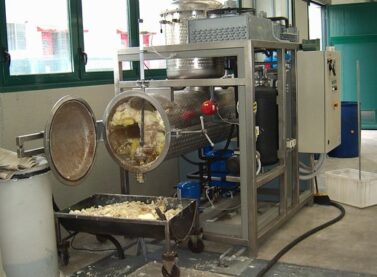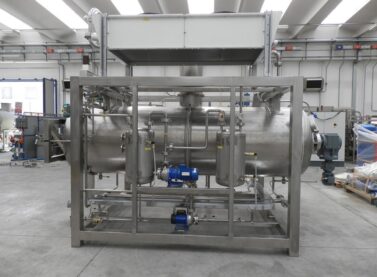Brine management and disposal
At Condorchem Envitech we have an extensive experience in the treatment of brines, which is the name given to the saline wastewater generated in industrial processes. We design, install and start-up wastewater treatment plants for brine management and disposal.
Our industrial brine treatment systems are designed to meet two main objectives:
- Desalination of the brine to obtain reusable clean water and produce a new brine in the form of a highly concentrated sludge (minimization of liquid waste) or as an absolutely solid waste (zero liquid discharge).
- Brine treatment to adapt the wastewater to the permitted discharge limits and send it to sewers, surface water, injection wells or environmental services providers.
In both cases, the treatment desalinates the brine and produces a more concentrated, lower volume liquid waste that is easier to manage.
Each brine has a unique composition that requires a personalized treatment to ensure a successful management and the optimization of the economic cost. For this reason, the characterization of brine is of great importance to know key parameters, such as salinity, scaling potential, as well as the content of metals or other contaminants.
At Condorchem Envitech we have carried out numerous projects for the treatment of brine and saline wastewater. Although there are different options for brine treatment, the most competitive technologies are membrane filtration and vacuum evaporation.
Membrane treatment
This option is of particular interest when the brine contains few contaminants apart from salts. The pretreatment necessary to preserve the useful life of the membranes should not be very complex.
In such cases, ultrafiltration followed by reverse osmosis are sufficient to produce a very high quality effluent and concentrated waste. Reverse osmosis supplies water of quality sufficient for the most demanding of applications.
Although Condorchem Envitech can design, build and deliver an all-in-one membrane solution best suited to the particular conditions of each customer, from the experience it has gathered, the following process types are of particular importance, depending on the application:
- Sea water desalination equipment: 1-1,000 m3/day
- Mains water purification equipment: 60-14,400 L/min
- Large scale special application equipment: from 200 L/h
Vacuum evaporation
Vacuum evaporation is for the treatment of complex mixtures not possible via conventional techniques. This produces high quality water and a highly concentrated residue that can be easily managed. The technology is clean, safe, very versatile and has a very low management cost.
The evaporators work under vacuum, so the boiling temperature of the liquid effluent is lower; thus saving energy and improving efficiency.
The range of Condorchem Envitech vacuum evaporators includes the following main equipment types:
- Heat pump vacuum evaporators
- Mechanical vapor recompression vacuum evaporators
- Multiple-effect vacuum evaporators
- Crystallizers
Different vacuum evaporator types have different specificities and, depending on the precise features in each case, you should choose the most convenient type and carefully design your specifications.
Crystallizers are usually applied as the final treatment phase to completely dry the brine residue. However, they can be used as a single treatment process in some applications.
In a large number of cases, the most efficient solution involves the design of a plant that combines both technologies, since it is common that membrane filtration technologies are not sufficient to obtain the desired results and it is necessary to extend the treatment with vacuum evaporation and crystallization.
Our brine management systems
Processes and technologies for brine treatment
The processes best positioned for brine and saline effluent treatment are membrane and vacuum evaporation processes.
The former concentrates the effluent and provides high quality water; while the latter effectively treats the brine, that is, converts it into effluent and products that can be discharged and managed easily.
Thus, vacuum evaporation converts the brine into water and a salt concentrate, which can be farther concentrated into a crystalline solid, if required.
The crystallization process can transform the paste concentrate into a crystalline solid that occupies little space and can be easily managed. Vacuum evaporation is the only technology that achieves the objective of zero discharge.
Why is brine management important
For a wide variety of reasons, a long list of industrial processes use brine and salt water, as is the case with product conservation in the food sector or as a coolant in electricity generation.
Brine is not toxic, but it cannot be discharged without being treated beforehand. This would have a significant environmental impact otherwise. The need for treatment is due to the high concentration of salts and possible contaminants captured during their use in the process.
Due to its high salt content, brine is usually difficult to treat by conventional methods; its management is complicated and can be very expensive.
When brine production is low, it can be managed externally. However, in most cases, the most economical option is to treat the brine before discharging it.
The main objective of the brine treatment is to remove dissolved sodium (Na) ions from the salt in the wastewater. Depending on the origin of certain brine wastewater, additional treatment may be necessary to remove other contaminants, such as metals and other ions that give water hardness, such as calcium (Ca).
Wastewater brine types
Brine and saline wastewater can be classified into two groups according to their contamination:
- Containing only dissolved saltsThis is the case with seawater and effluents from water purification plants (e.g. decalcifiers and reverse osmosis reject solution).
- Containing other contaminants as well as saltsEffluent from the textile industry, food industry and leachate from municipal solid waste landfills, for example.
Depending on the contaminants in the brine, the most appropriate treatment option is to use different technologies. Industrial saline water is a complex mixture in terms of composition, so vacuum evaporation is one of the most competitive options.
Sectors and applications
Brine is used in a variety of industrial processes, the most important being the following:
- Desalination of seawater: Drinking water production via the desalination of seawater or brackish water has been expanding in recent decades in all areas where there is a lack of water. It is estimated that there are currently over 16,000 desalination plants around the world. Whatever the technology used in desalination, in all cases a brine stream is produced that must be managed.
- Textile industry: The textile industry consumes a large amount of water, which must be high quality. The water used, whether obtained from the distribution network or from other sources, is often subjected to a purification, normally a softening, process. As a result, when the ion exchange columns are regenerated, an effluent with a high salt concentration is produced.Also, in the process of dyeing textiles, high salt concentrations are used in the water to increase the textile fiber pigmentation process efficiency. This effluent contains large amounts of organic matter, in addition to having a high salt content.
- Municipal solid waste dumps: Leachates produced from municipal waste landfill sites are of complex composition and have to be treated before discharge, to prevent a detrimental environmental impact. As a consequence of this treatment, a concentrated effluent containing all the salts originally present in the leachate is produced.
- Food industry: To prevent microorganisms attacking food and to keep it for long periods of time, salting and brine preservation techniques have historically been used. The brine is usually prepared by dissolving sodium chloride and sodium nitrite in cold water at concentrations of 15-20%. In the process of preparing these foods, significant effluents of brine are produced.This also occurs in the preparation of pickles (a marinate of brine and vinegar to keep olives, gherkins, carrots or onions, for example), which need high salt concentration solutions.
- Wastewater treatment plants: A large number of industries use high quality (ultra-pure) water for use in their production processes; especially the pharmaceutical, food and textile industries. Such industries typically use ion exchange resins to soften water or membrane-based processes (nanofiltration or reverse osmosis) for more complete treatment.As a result of this purification, effluents are produced that concentrate all the salts and impurities removed from the raw water, and are notable for their high concentration of dissolved salts.
- Leather industry: The leather tanning industry is notable for its high contamination potential, due to both the reagents used and the effluents produced in the different processes.Generally, the processes used in the tanning of animal skins are salting (with NaCl), softening (using sodium sulfide, sodium polysulfide or sodium carbonate), unhairing (using sodium sulfide, sodium hydrosulfide, amines, calcium hydroxide and caustic soda), liming (in a bath of caustic soda), deliming (using hydrochloric acid, sulfuric acid, boric acid, ammonium chloride, ammonium acetate and cyclic esters), pickling (chromium salts and formaldehyde), tanning, lubrication, drying, conditioning and finishing (using dyes and aniline).
The chemicals used in the different processes are incorporated into the wastewater as they are used.
Although the effluents are treated to remove all contaminants present, the salts used are concentrated and the effluents have salt concentrations of up to 10,000 mg/L.
- Power generation plants: Energy-generation plants need water of the highest quality to operate. This water is transformed into high temperature steam, which moves the alternator. The ultra pure water used is generally obtained by subjecting mains water, or that from catchment systems, to a treatment process.This process generates a waste effluent that concentrates all the impurities removed from the water. Such effluents are characterized by their high salt concentration and must therefore be treated prior to discharge.
- Gas and oil extraction: The gas and oil industry is also capable of producing significant brine effluents. A large number of gas and oil wells are found close to seams of rock salt. The technique used to extract oil comprises drilling wells into which fresh water, which dissolves the salt and returns to the surface as a brine, is injected. Oil is recovered by displacing it towards the surface by injecting water or brine. The excess brine should be treated before being discharged.
- Chemical and pharmaceutical industry: In the chemical and pharmaceutical industries, brine is frequently used as a coolant fluid, due to its properties, low price and low toxicity.






